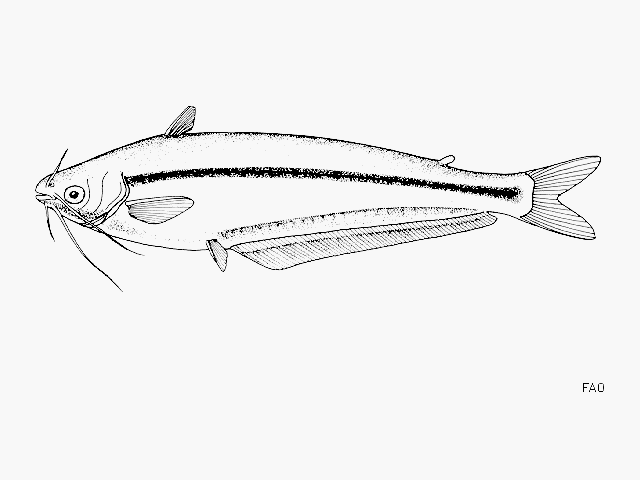| Schilbeidae (Schilbid catfishes) |
| 9.2 cm SL (male/unsexed) |
|
demersal; freshwater |
| Africa: Ruvu, Rufiji-Great Ruaha and Ruvuma systems in Tanzania, and lakes Chiuta and Chilwa in Mozambique and Malawi (Ref. 43912). |
|
Dorsal spines (total): 1-1; Dorsal soft rays (total): 3-4; Anal spines: -0; Anal soft rays: 50. Diagnosis: two pairs of mandibular barbels; adipose fin small; dorsal fin with only 3-4 soft branched rays; at least 50 branched anal fin rays; 13-15 gill rakers on lower part of anterior branchial arch (Ref. 43912).
Description: 9-10 branched pectoral fin rays; anal with iii-iv unbranched and 49-60 branched soft fin rays, number of anal fin rays rather variable from one population to another; 41-43 non-fused vertebrae; 8-9 branchiostegal rays on one side of head; caudal peduncle deeper than long; nasal barbel reaches at least to midway between eye and opercle and at maximum to posterior border of opercle; maxillary barbel rather long and reaches at least to midway along pectoral spine and at maximum to just before its end; inner mandibular barbel reaches at least to posterior border of eye and at maximum to anterior border of opercle; outer mandibular barbel longest and always reaches to about distal end of pectoral spine; inner side of pectoral spine feebly or extremely feebly serrated, in some specimens irregularities on posterior side of spine hardly recognizable as serrations; head rather broad; band of teeth on palatine continuous or narrowly interrupted in middle; snout reaching slightly beyond lower jaw; caudal fin deeply notched with long and pointed fin lobes (Ref. 43912). A peculiar species with a striking reduction of the dorsal fin; P. longifilis is easily distinguished from its congeners by the large number of gill rakers on the anterior gill-arch and by the numerous soft anal fin rays (Ref. 43912).
Coloration: preserved specimens: head and back brown; dark spot above pectoral fin; dark lateral stripe present along lateral line; short dark horizontal stripe starts at base of pectoral spine and ends at level of origin of anal fin; third dark line extends above base of anal; superior border of upper caudal fin lobe sometimes darkly coloured; anal fin border sometimes grey-brown, other fins generally colourless or faintly pigmented at distal margins (Ref. 43912). Live specimens: silvery-white on flanks, with brown longitudinal lines along lateral line and above base of anal fin; belly white; head and back brown; fins uncoloured (Ref. 43912). |
| Inhabits flowing rivers (Ref. 4967). Feeds at least partly on aquatic and terrestrial insects (Ref. 43912). Oviparous, eggs are unguarded (Ref. 205). Maximum reported total length about 11 cm (Ref. 43912). |
|
Least Concern (LC); Date assessed: 20 July 2018 Ref. (130435)
|
| harmless |
Source and more info: www.fishbase.org. For personal, classroom, and other internal use only. Not for publication.
